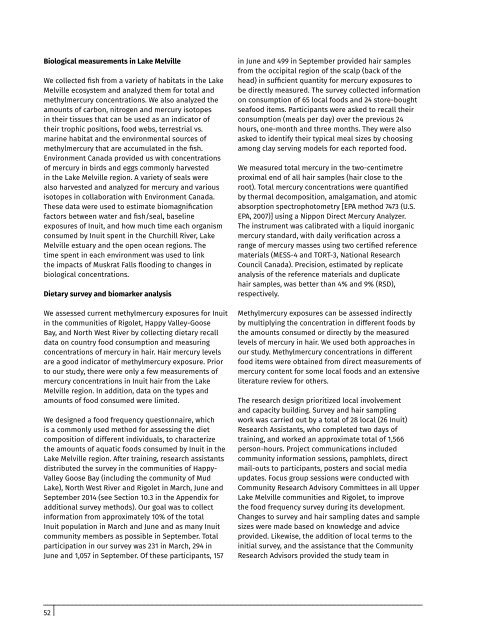Lake Melville
1rw7Mns
1rw7Mns
You also want an ePaper? Increase the reach of your titles
YUMPU automatically turns print PDFs into web optimized ePapers that Google loves.
Biological measurements in <strong>Lake</strong> <strong>Melville</strong><br />
We collected fish from a variety of habitats in the <strong>Lake</strong><br />
<strong>Melville</strong> ecosystem and analyzed them for total and<br />
methylmercury concentrations. We also analyzed the<br />
amounts of carbon, nitrogen and mercury isotopes<br />
in their tissues that can be used as an indicator of<br />
their trophic positions, food webs, terrestrial vs.<br />
marine habitat and the environmental sources of<br />
methylmercury that are accumulated in the fish.<br />
Environment Canada provided us with concentrations<br />
of mercury in birds and eggs commonly harvested<br />
in the <strong>Lake</strong> <strong>Melville</strong> region. A variety of seals were<br />
also harvested and analyzed for mercury and various<br />
isotopes in collaboration with Environment Canada.<br />
These data were used to estimate biomagnification<br />
factors between water and fish/seal, baseline<br />
exposures of Inuit, and how much time each organism<br />
consumed by Inuit spent in the Churchill River, <strong>Lake</strong><br />
<strong>Melville</strong> estuary and the open ocean regions. The<br />
time spent in each environment was used to link<br />
the impacts of Muskrat Falls flooding to changes in<br />
biological concentrations.<br />
Dietary survey and biomarker analysis<br />
We assessed current methylmercury exposures for Inuit<br />
in the communities of Rigolet, Happy Valley-Goose<br />
Bay, and North West River by collecting dietary recall<br />
data on country food consumption and measuring<br />
concentrations of mercury in hair. Hair mercury levels<br />
are a good indicator of methylmercury exposure. Prior<br />
to our study, there were only a few measurements of<br />
mercury concentrations in Inuit hair from the <strong>Lake</strong><br />
<strong>Melville</strong> region. In addition, data on the types and<br />
amounts of food consumed were limited.<br />
We designed a food frequency questionnaire, which<br />
is a commonly used method for assessing the diet<br />
composition of different individuals, to characterize<br />
the amounts of aquatic foods consumed by Inuit in the<br />
<strong>Lake</strong> <strong>Melville</strong> region. After training, research assistants<br />
distributed the survey in the communities of Happy-<br />
Valley Goose Bay (including the community of Mud<br />
<strong>Lake</strong>), North West River and Rigolet in March, June and<br />
September 2014 (see Section 10.3 in the Appendix for<br />
additional survey methods). Our goal was to collect<br />
information from approximately 10% of the total<br />
Inuit population in March and June and as many Inuit<br />
community members as possible in September. Total<br />
participation in our survey was 231 in March, 294 in<br />
June and 1,057 in September. Of these participants, 157<br />
in June and 499 in September provided hair samples<br />
from the occipital region of the scalp (back of the<br />
head) in sufficient quantity for mercury exposures to<br />
be directly measured. The survey collected information<br />
on consumption of 65 local foods and 24 store-bought<br />
seafood items. Participants were asked to recall their<br />
consumption (meals per day) over the previous 24<br />
hours, one-month and three months. They were also<br />
asked to identify their typical meal sizes by choosing<br />
among clay serving models for each reported food.<br />
We measured total mercury in the two-centimetre<br />
proximal end of all hair samples (hair close to the<br />
root). Total mercury concentrations were quantified<br />
by thermal decomposition, amalgamation, and atomic<br />
absorption spectrophotometry [EPA method 7473 (U.S.<br />
EPA, 2007)] using a Nippon Direct Mercury Analyzer.<br />
The instrument was calibrated with a liquid inorganic<br />
mercury standard, with daily verification across a<br />
range of mercury masses using two certified reference<br />
materials (MESS-4 and TORT-3, National Research<br />
Council Canada). Precision, estimated by replicate<br />
analysis of the reference materials and duplicate<br />
hair samples, was better than 4% and 9% (RSD),<br />
respectively.<br />
Methylmercury exposures can be assessed indirectly<br />
by multiplying the concentration in different foods by<br />
the amounts consumed or directly by the measured<br />
levels of mercury in hair. We used both approaches in<br />
our study. Methylmercury concentrations in different<br />
food items were obtained from direct measurements of<br />
mercury content for some local foods and an extensive<br />
literature review for others.<br />
The research design prioritized local involvement<br />
and capacity building. Survey and hair sampling<br />
work was carried out by a total of 28 local (26 Inuit)<br />
Research Assistants, who completed two days of<br />
training, and worked an approximate total of 1,566<br />
person-hours. Project communications included<br />
community information sessions, pamphlets, direct<br />
mail-outs to participants, posters and social media<br />
updates. Focus group sessions were conducted with<br />
Community Research Advisory Committees in all Upper<br />
<strong>Lake</strong> <strong>Melville</strong> communities and Rigolet, to improve<br />
the food frequency survey during its development.<br />
Changes to survey and hair sampling dates and sample<br />
sizes were made based on knowledge and advice<br />
provided. Likewise, the addition of local terms to the<br />
initial survey, and the assistance that the Community<br />
Research Advisors provided the study team in<br />
52


